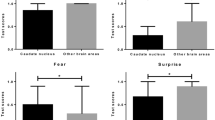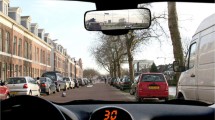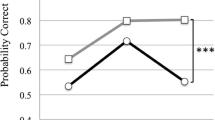Abstract
Extent of cerebellar involvement in cognition and emotion is still a topic of ongoing research. In particular, the cerebellar role in humor processing and control of laughter is not well known. A hypermetric dysregulation of affective behavior has been assumed in cerebellar damage. Thus, we aimed at investigating humor comprehension and appreciation as well as the expression of laughter in 21 patients in the acute or subacute state after stroke restricted to the cerebellum, and in the same number of matched healthy control subjects. Patients with acute and subacute cerebellar damage showed preserved comprehension and appreciation of humor using a validated humor test evaluating comprehension, funniness and aversiveness of cartoons (“3WD Humor Test”). Additionally, there was no difference when compared to healthy controls in the number and intensity of facial reactions and laughter while observing jokes, humorous cartoons, or video sketches measured by the Facial Action Coding System. However, as depression scores were significantly increased in patients with cerebellar stroke, a concealing effect of accompanying depression cannot be excluded. Current findings add to descriptions in the literature that cognitive or affective disorders in patients with lesions restricted to the cerebellum, even in the acute state after damage, are frequently mild and might only be present in more sensitive or specific tests.




Similar content being viewed by others
References
Wild B, Rodden FA, Grodd W, Ruch W. Neural correlates of laughter and humour. Brain. 2003;126(Pt 10):2121–38.
Wild B, Rodden FA, Rapp A, Erb M, Grodd W, Ruch W. Humor and smiling: cortical regions selective for cognitive, affective, and volitional components. Neurology. 2006;66(6):887–93.
Buckner RL, Krienen FM, Castellanos A, Diaz JC, Yeo BT. The organization of the human cerebellum estimated by intrinsic functional connectivity. J Neurophysiol. 2011;106(5):2322–45.
Strick PL, Dum RP, Fiez JA. Cerebellum and nonmotor function. Annu Rev Neurosci. 2009;32:413–34.
Zhu JN, Yung WH, Kwok-Chong Chow B, Chan YS, Wang JJ. The cerebellar-hypothalamic circuits: potential pathways underlying cerebellar involvement in somatic-visceral integration. Brain Res Rev. 2006;52(1):93–106.
Schmahmann JD, Weilburg JB, Sherman JC. The neuropsychiatry of the cerebellum—insights from the clinic. Cerebellum. 2007;6(3):254–67.
Sacchetti B, Scelfo B, Strata P. Cerebellum and emotional behavior. Neuroscience. 2009;162(3):756–62.
Bartolo A, Benuzzi F, Nocetti L, Baraldi P, Nichelli P. Humor comprehension and appreciation: an FMRI study. J Cogn Neurosci. 2006;18(11):1789–98.
Goel V, Dolan RJ. The functional anatomy of humor: segregating cognitive and affective components. Nat Neurosci. 2001;4(3):237–8.
Moran JM, Wig GS, Adams Jr RB, Janata P, Kelley WM. Neural correlates of humor detection and appreciation. NeuroImage. 2004;21(3):1055–60.
Shammi P, Stuss DT. The effects of normal aging on humor appreciation. J Int Neuropsychol Soc. 2003;9(6):855–63.
Frank B, Propson B, Goricke S, Jacobi H, Wild B, Timmann D. Humor and laughter in patients with cerebellar degeneration. Cerebellum. 2011;11:564–73.
Trouillas P, Takayanagi T, Hallett M, Currier RD, Subramony SH, Wessel K, et al. International Cooperative Ataxia Rating Scale for pharmacological assessment of the cerebellar syndrome. The Ataxia Neuropharmacology Committee of the World Federation of Neurology. J Neurol Sci. 1997;145(2):205–11.
Huber W, Poeck K, Weniger D, Willmes K. Aachener Aphasie Test (AAT). Göttingen: Hogrefe; 1983.
Gröne B, Engl E-M, Kotten A, Ohlendorf I, Poser E. Bildmaterial zum Sprachverständnis: Übungen zu Phonologie, Semantik und Syntax. Dortmund: Borgmann; 2000.
Ruch W. Assessment of appreciation of humor: Studies with the 3WD humor test. In: Spielberg CD, Butcher JN, editors. Advances in personality assessment. Hillsdale: Erlbaum; 1992. p. 27–75.
Ekman P, Friesen WV. Facial action coding system (FACS). Palo Alto: Consulting Psychologists; 1978.
Ekman P, Davidson RJ, Friesen WV. The Duchenne smile: emotional expression and brain physiology. II. J Pers Soc Psychol. 1990;58(2):342–53.
Martin RA, Lefcourt H. Sense of humor as a moderator of the relation between stressors and moods. J Pers Soc Psychol. 1983;45:1313–24.
Ruch W, Köhler G, van Thiel C. Assessing the “humorous temperament”: construction of the facet and standard trait forms of the State-Trait Cheerfulness Inventory STCI. Humor: International Journal of Humor Research. 1996;9:303–39.
Ruch W, Köhler G, van Thiel C. To be in good or bad humor: construction of the state form of the State-Trait-Cheerfulness-Inventory STCI. Personal Individ Differ. 1997;22:477–91.
Beck AT, Ward CH, Mendelson M, Mock J, Erbaugh J. An inventory for measuring depression. Arch Gen Psychiatry. 1961;4:561–71.
Berg A, Lonnqvist J, Palomaki H, Kaste M. Assessment of depression after stroke: a comparison of different screening instruments. Stroke. 2009;40(2):523–9.
Diedrichsen J, Balsters JH, Flavell J, Cussans E, Ramnani N. A probabilistic MR atlas of the human cerebellum. NeuroImage. 2009;46(1):39–46.
Diedrichsen J, Maderwald S, Kuper M, Thurling M, Rabe K, Gizewski ER, et al. Imaging the deep cerebellar nuclei: a probabilistic atlas and normalization procedure. NeuroImage. 2011;54(3):1786–94.
Karnath HO, Himmelbach M, Rorden C. The subcortical anatomy of human spatial neglect: putamen, caudate nucleus and pulvinar. Brain. 2002;125(Pt 2):350–60.
Hackett ML, Yapa C, Parag V, Anderson CS. Frequency of depression after stroke: a systematic review of observational studies. Stroke. 2005;36(6):1330–40.
Uekermann J, Channon S, Lehmkamper C, Abdel-Hamid M, Vollmoeller W, Daum I. Executive function, mentalizing and humor in major depression. J Int Neuropsychol Soc. 2008;14(1):55–62.
Falkenberg I, Jarmuzek J, Bartels M, Wild B. Do depressed patients lose their sense of humor? Psychopathology. 2011;44(2):98–105.
Dum RP, Strick PL. An unfolded map of the cerebellar dentate nucleus and its projections to the cerebral cortex. J Neurophysiol. 2003;89(1):634–9.
Küper M, Dimitrova A, Thurling M, Maderwald S, Roths J, Elles HG, et al. Evidence for a motor and a non-motor domain in the human dentate nucleus—an fMRI study. NeuroImage. 2011;54(4):2612–22.
Liu L, Zeng LL, Li Y, Ma Q, Li B, Shen H, et al. Altered cerebellar functional connectivity with intrinsic connectivity networks in adults with major depressive disorder. PLoS One. 2012;7(6):e39516.
Ekman P, Friesen WV, Hager JC. Facial action coding system—the manual. Salt Lake City: Research Nexus division of Network Information Research Corporation; 2002.
Conflict of Interest
I certify that there is no actual or potential conflict of interest in relation to this article
Author information
Authors and Affiliations
Corresponding author
Electronic Supplementary Material
Below is the link to the electronic supplementary material.
ESM 1
(PDF 80 kb)
Rights and permissions
About this article
Cite this article
Frank, B., Andrzejewski, K., Göricke, S. et al. Humor, Laughter, and the Cerebellum: Insights from Patients with Acute Cerebellar Stroke. Cerebellum 12, 802–811 (2013). https://doi.org/10.1007/s12311-013-0488-5
Published:
Issue Date:
DOI: https://doi.org/10.1007/s12311-013-0488-5




